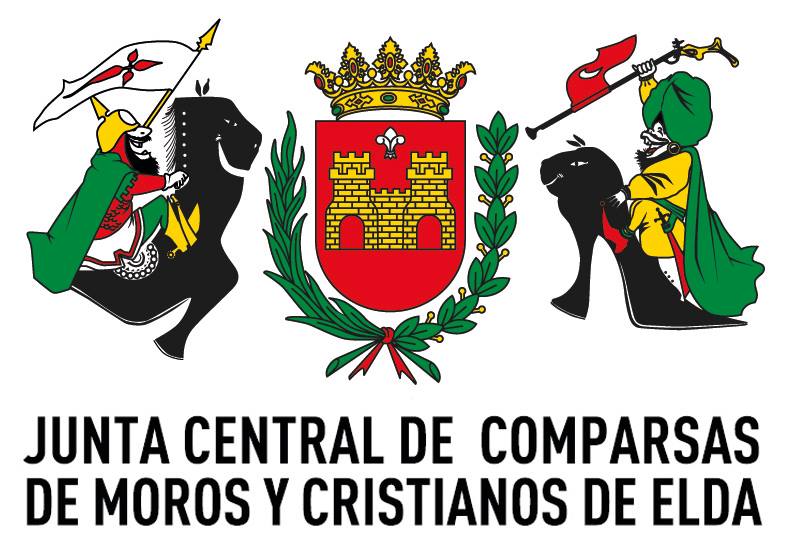Events
The Media Fiesta, merged with the traditional festival of San Antón, is celebrated during two weekends of the month of January: the first weekend, prior to the liturgical festival of the Saint, takes place the opening of the exhibition of photographs on Friday , and the parade of collas and musical groups of the Saturday afternoon.
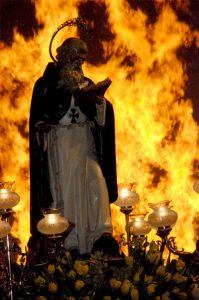
On 17 January, the liturgical festival of San Antonio Abad, it’s celebrated – as is the tradition – the parade of the Stewardship, Central Board of Troupes and Civil and Religious Authorities to the chapel of the Anchorite Saint, where the mass takes place in honor of the Saint, the blessing and distribution of bread, after which the bonfire is lit in its vicinity, the festival goers carry the saint around it, the typical dances of the feast are interpreted and fireworks are thrown.
On the second weekend, the main events of the Media Fiesta take place. On Saturday morning the protagonist is the Stewardship of the Saint with the celebration of the typical porrate, cucañas and children’s games and, again, the typical dances, all enlivened by the dulzaina and the tamboril. In the afternoon there is a parade of all the troupes, led by the Flag Bearers and Captains and the banner of the Saint, accompanied by the Authorities, Stewardship and Central Board, to the Saint’s chapel from where his sacred statue is transferred to the church of Santa Ana, where he is received by a multitude of festive people and placed at the head of the high altar. Once there, the paso doble that bears his name is interpreted.
On Sunday morning, the High Mass in honour of the Saint is celebrated in the church of Santa Ana with the attendance of the officials, Central Board, Stewardship and Authorities and, after the religious celebration, in the same setting and in the presence of the statue of San Antón, the Proclamation of the Captains and Flag bearers, both adults and children, takes place for the next festive edition of the month of June. Afterwards, the sacred statue of San Antón is taken back to its chapel with shots from arquebusiers, receiving the homage of the squads that participate in the Media Fiesta and the shooting of a great mascletá at its entrance in the sacred enclosure. Finally, the Media Fiesta Parade is held, with the participation of the Ambassadors with their special squads, the troupes, represented by their outgoing and incoming festive positions, and the four squads designated for the occasion, as well as the respective music bands. The route is the same as the Christian and Moorish Parade and is witnessed by a large crowd of festive people and citizens.
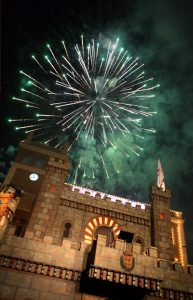
Since 2003 the Proclamation is pronounced from the Embassy Castle on the Wednesday before the beginning of the Festival, at 11 o’clock at night, and after it the firework display that starts the days of the Festival takes place. Previously, the Flag Bearers and Captains and the Santa Cecilia band accompany the Town Crier, Authorities and Central Board from the Casa de Rosas -the headquarters of the Central Board- to the castle installed in the Plaza de la Constitución. With all this, the opening speech has become a multitudinous act, a true announcer and the driving force behind the festival, which begins the following day with the entrance of the bands.
Feast of Moors and Cristians
Thursday
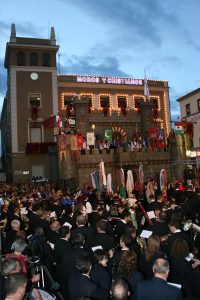
This event begins in the Zapatero square at eight o’clock in the evening on Thursday, the first day of the celebration. It is initiated by the local Band Santa Cecilia accompanying the municipal and festive authorities as well as the director who will direct the paso doble from the battlements of the castle, all of them preceded by the Flag of Central Meeting that initiates, in a symbolic way, the celebration. After the local band, is carried out a parade of the nine bands corresponding to the bands that make up our festivity and representing the rest of the bands participating in it. Each band is preceded only by the banner of the group that represents, carried by a prominent member of the group who fits such an honor. Each of the bands plays a different paso doble or marching song that has been previously communicated to the Central Board. The bands must be uniformed, with a significant number of musicians and preceded by their corresponding flags.
When all the bands arrive at the Town Hall Square, the Presidents of the troupes give a commemorative bow tie to the band that represents them while the Mayor of Elda does the same honor to the band Santa Cecilia.Then the Mayor, as the first authority, say a few words from the castle to all the people of congratulation and encouragement for the celebration that begins. After this, the designated director raises the baton and begins the interpretation of Idella, anthem of the festivity, that is chanted by the thousands of people that cram the square, the Colón street and the adjacent ones.The applause, together with the mascletá that is fired and the joyful ringing of the bells of Santa Ana church, end this act that is, neither more nor less, than the explosion of joy contained for a whole year and that emerges in this moment when the celebration begins.
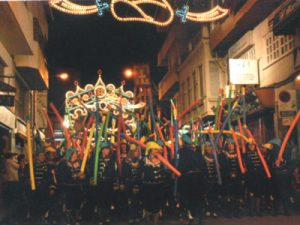
Today the Retreta is still a happy and informal act, as it was in the past, but without losing its festive character. All the participants wear the guerrilla costume and let themselves be accompanied by the traditional music of the paso dobles or festive marches. It begins at midnight and runs along the same route as the main parade in front of a massive presence of an expectant audience that enjoys the innovations of recent years: several troupes present groups of festive people who parade making different and beautiful marches directed by a corporal to the sound of the music of marches specially composed for this way of parading. The Muslims began, the Gypsies followed, and now the Pirates, the Students, the Cadi’s Hosts and the Moroccans also perform.
Friday
In 1995, the new Central Board that emerged from the ballot box wanted to give priority to these acts, which until then had been done in a somewhat anarchic way, giving them a new organization and forcing the groups not to play music that was not properly festive. This is how it happens in the one that takes place on Friday morning, also shortening the parade of troupes that will leave since then from the Zapatero square. As for the transfer to the chapel on Monday night, once the Procession is over, it is organized in a different way to how it was being celebrated: the image of the Saint and the group that carries it must reach the steps of the Santa Ana Church, where the general Procession ends with the firing of a large palm tree with fireworks from the towers of that church. Then, the transfer to the chapel takes place with the official accompaniment of the Flag Bearers and Captains, adults and children, the Stewardship, Authorities and Central Board. When the image enters the chapel, a great pyrotechnic dawn is set off.
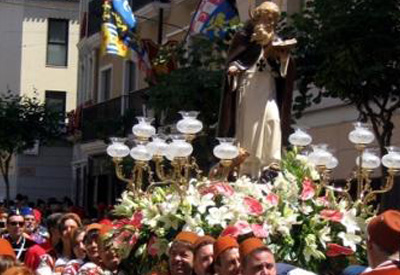
From the year 2000, the route of the Friday morning parade was changed, extending it through various streets of the historical center to the chapel, because the previous route had become obsolete due to the increasing number of festival-goers who participated in it. Also during those years, the archebusiers shot that opened the parade to the chapel from Dahellos street was recovered.
The last remodelling of this act on Friday morning consists of having only the archebusiers participate in the parade to the chapel, accompanying the banner of the Saint from the headquarters of the Central Board with their thunderous shots. When they arrive at the chapel, the parade begins to move the Saint to the church of Santa Ana with all the festive people. It runs along Independencia, Andrés Amado, Espoz y Mina, Plaza Constitución, Colón, Nueva, Ortega y Gasset and San Francisco streets. The entrance of the statue of San Antón in the church is apotheosis: archebusiers salute, interpretation of the paso doble dedicated to the Saint, turning of the bells and cheers and applause from a crowd of festive people who acclaim him with emotion. Once, inside the temple, an act that has emerged spontaneously takes place. It consists of words of welcome from the parish priest, and the interpretation – again by the Santa Cecilia band – of the paso doble-hymn “A San Antón” which is chanted by all those present while the image is enthroned on the high altar of our main and archpriestly church.
The profound restructuring of the Festival carried out in 1991, in order to add one more day to the festive events so that they could be held more fluently and amenity, led to the children’s parade being held on Friday afternoon, specifically at 7 p.m. In spite of the reticence of many festive people, and even of some groups, the parade fulfilled all the expectations and was very brilliant, winning in attendance of festive and not festive spectators.
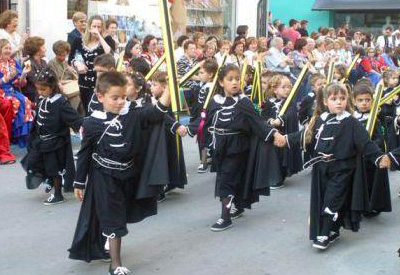
From that year onwards, the parade has been increasing in spectacularity, incorporating new elements that make it bigger: in 1993, a percussion collage of the Muslims’ group came out for the first time, opening the parade as a pomp and circumstance to accompany their Flag bearer and Captain. Since then, every year the groups that lead the parade usually have a small or large pomp. We must highlight the commemoration of Muslims and Gypsies in its 50 years of existence, as well as the proliferation of bands of the four Moorish troupes and the Gypsy Fanfare, which have been joined in recent years the Pirate Leeward Group, the Smuggler Skirmish and the Ballad of the Christians’ troupe, which have made it possible for this parade to acquire even greater relevance. The musical groups of the troupes, ballets, banners and other paraphernalia are today one more element that opens each of the sides in this peculiar and splendid Children’s Parade of our celebration. In 2009 the new group of the Students’ troupe, which has been called The Anvil, opened the parade of the troupe itself as a pomp as it was due that year.
The initial pomp is a splendid reality that every year the troupes that open their side – be they Moorish or Christian – reflect. In the last editions of the festival, some schools in the city with their children, teachers and mothers themselves, set up these pomps, which are more and more original in their approach and staging: These schools have been the protagonists of the opening of several of the troupes in recent years, and the varied rhythm of the musical groups of the troupes themselves- Moorish bands, Fanfare, Leeward, Skirmish, Ballad or Anvil- make this parade a real pleasure for those who are lucky enough to contemplate the evolution of their children’s blocks, squad capes, small black squads, crowded floats, and the illusion and charm that the Flag Bearers and Captains exude. This is the true “crown jewel” of our celebration.
Saturday
In our Moors and Christians Festival these acts are among the few truly irreplaceable.
In 1983 an essential change was introduced in the Embassies: the texts that the
Ambassadors had recited since the reappearance of the festivities in 1945 were discarded, and those currently used in the June festivities were introduced. For the Moorish Embassy, the text from Alcoy was chosen – one of the oldest known festive parliaments – attributed to our fellow countryman D. Juan Rico y Amat, a romantic writer and poet who was political leader and mayor appointed by the king in Alcoy from 1848 to 1850. As for the text of the Christian Embassy, it was adopted the one that with the name of The Flag of the Cross wrote last century the famous poet from Elda D. Francisco Laliga Gorgues, brought to light by Alberto Navarro Pastor in the Moors and Christians’ magazine from Elda in 1967.
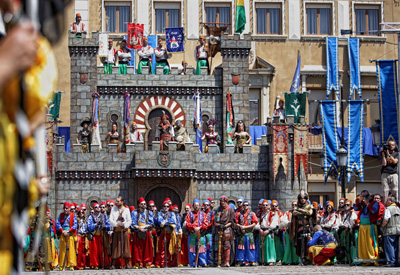
In 1984 it was decided, with very good opinion, to move the celebration of the act of the Embassies to the Town Hall Square, neuralgic center of the city, which was a complete success of public and organization. For this purpose, a pomp was organized for each of the Embassies that caused a sensation and served to enhance the accompaniment of each Ambassador to the castle. This procession was already established as an obligatory part of the itinerary from the confluence of Pemán and Antonino Vera streets to Padre Manjón, Chapí, Antonio Maura, Nueva and Colón avenues.
In 1994, the year of the fiftieth anniversary of our Festival, the organizing committee introduced the element of the Estafeta in both Embassies. It consists of an emissary on horseback carrying a message to the castle with a request for the return of the fortress that is despised with displeasure. These acts have incorporated other innovations in this last stage of our Festival that have given this act a great deal of emotion. The organization of the firing of the groups in the assault to the castle along Colón Street is remarkable, which has gained in security and aesthetics, and the consequent “encaro” or confrontation of the Captains that ends with the embrace and congratulations of the top officials of the Festival at the gates of the castle.
Since 2009, two great festive people have been in charge of reciting the embassies of our Festival. They are Isidro Juan Gallardo as Christian Ambassador and Damián Varea del Amo as Moorish Ambassador, who have stood out for their good work and their performance of true dramatic vein, as they belong to an amateur theatre group from Elda.
At the moment, both the guerrillas or Alardo and the Embassies constitute one of the most careful and interesting acts of the Elda festivities: every year more and more people participate in them and many more spectators witness them in the framework of the Constitución square, in front of the magnificent wooden castle located in front of the Town Hall, which was inaugurated a few years ago, and which is a symbol of our entire Festival. The courier, the pomp, the entourage of the Ambassador, the Embassy itself, the battle of arquebusiers and the final hand-to-hand fight of the Ambassadors in the assault on the fortress, constitute the structure of an essential act to understand the reality and authenticity of a Moors and Christians Festival like ours.
This act is perhaps one of the most important of the Festival due to the spectacularity it has acquired over the years. It symbolizes the entry into the town of the Christian armies which, in some way, come to reinforce the inhabitants of the town in their fight against the Muslim invader. However, in our annual festive representation, both sides participate in the parade, although the Christians are the ones who open it, and that is why it is called the Christian Entrance.
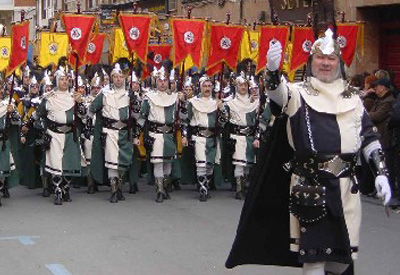
In the year 1995 the Pirates troupe celebrates its fiftieth anniversary with the Festival and for that reason, in addition to other activities, they present a great pomp that opens the Christian Entrance, after the entourage of the Ambassador. From that moment every year the group that opens the parade offers a pomp that extols the participation of its flag bearer and captain. Thus the “Triumphal Christian Entrance”, as it now reads in the programs that are published to announce and propagate the Festival, is led each year by an entourage that surrounds the Christian Ambassador and then the initial pomp of the group that opens the parade that has clear connotations in line with the group that represents and its clothing. It is necessary to emphasize the presence of ballets, “collas” or native musical groups, floats, blocks or platoons that carry out some type of evolution in their parade, and other elements that cause that the beginning of the Entrance is waited for by the public by the every time better putting in scene that carry out the troupes, that try to surprise and to astonish the spectators with these splendid and full pomps of enchantment.
The order of the troupes in this parade is always rotary, so the troupe that starts the parade takes the last place on the side and goes down until it is again the first place. After the Christian groups, the Moorish march in a continuous succession of squads, festive bands and music that covers the entire Saturday night of the festival, ending around midnight.
Sunday
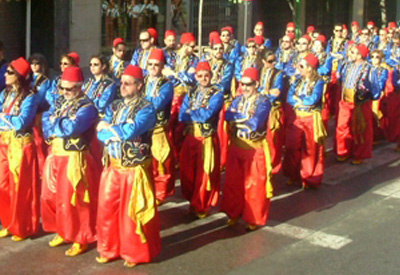
This event, which at first had very little impact, is now a beautiful event that every year concentrates in the Town Hall Square more festive people who travel a long route (Colon, Maura, Chapi, Padre Manjon, A. Vera, Peman, Dahellos, Jardines and Juan Carlos streets).
Under the pleasant morning coolness that the deserted streets of Elda breathe, the festive people march with a happy and colourful step to receive again -after an agitated night of authentic festive march- the festival in its true essence.
La Diana, which has a magnificent participation of festive people and spectators in other towns where it has a true root, in our town is beginning to reach a good degree of participation and uniformity and, what is more important, has become a true act of festive confraternity when the participants of each troupe wait for those of the others at the end of the route to correspond to their performance with applause, showing the accented festive spirit that they carry in their hearts.
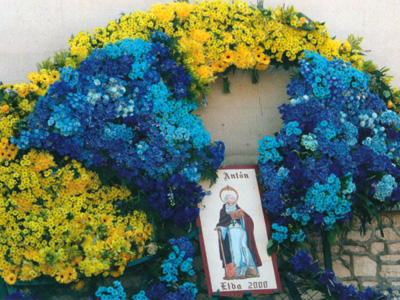
From 1995 to date, the Offering Parade is already emerging as in honor of the anchorite Saint, patron of the Moorish-Christian celebrations whose image presides over the mural where the flowers that they celebrate in each group are placed and the Offering of the Flag bearers in the presence of the statue of San Antonio Abad on the main altar. This act, in which the festive charges of each troupe shine with its own light, begins on Juan Carlos I Street and continues through Juan Carlos I, Sagasta Square, Gardens, Ortega and Gasset, Nueva, Colón and Purísima until the very gates of the parish temple.
The subsequent concelebrated Mass in honor of San Antonio Abad brings together all the parish priests of the city with the guest preacher every year. Since 1998 the compositions dedicated to San Antón composed by the musician Jesús Mula, whose interpretation is in charge of the Choir of the Patron Saints and the Santa Cecilia Band, directed by Mª Carmen Segura.
In the last years at the end of the Mass, and after the firing of the traditional mascletá, the exit of the temple is organized with a parade of accompaniment of charges from San Francisco street to Ortega y Gasset street, from where each troupers headed to its corresponding headquarters.
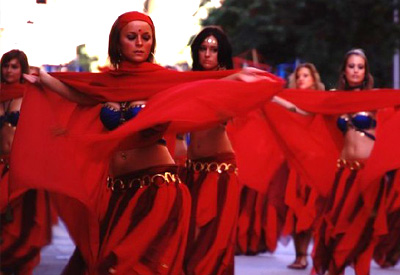
The Moorish entrance is currently held on the Sunday of the festival at 6pm. It is opened by the Moorish Ambassador with his entourage accompanied by the band Santa Cecilia, and then the group that takes turns to start the parade presents a pomp in keeping with their own idiosyncrasy. All the troupes have presented pomp in this parade, but I think it would be unworthy not to mention the splendor of the Muslim troupe in 1997, on the occasion of its 50th anniversary, or the Cadi’s Hosts (2001) to celebrate its twenty-five years of participation in the festivities. This parade, which is described in the programs as “majestic Moorish Entrance”, receives this name because it is led by the Moorish side, which is followed by the Christian side. The order is rotating, as it happens in the Christian Entrance, since the group that opens the parade the following year closes it.
Monday
In our Moors and Christians Festival these acts are among the few truly irreplaceable.
In 1983 an essential change was introduced in the Embassies: the texts that the
Ambassadors had recited since the reappearance of the festivities in 1945 were discarded, and those currently used in the June festivities were introduced. For the Moorish Embassy, the text from Alcoy was chosen – one of the oldest known festive parliaments – attributed to our fellow countryman D. Juan Rico y Amat, a romantic writer and poet who was political leader and mayor appointed by the king in Alcoy from 1848 to 1850. As for the text of the Christian Embassy, it was adopted the one that with the name of The Flag of the Cross wrote last century the famous poet from Elda D. Francisco Laliga Gorgues, brought to light by Alberto Navarro Pastor in the Moors and Christians’ magazine from Elda in 1967.
In 1984 it was decided, with very good opinion, to move the celebration of the act of the Embassies to the Town Hall Square, neuralgic center of the city, which was a complete success of public and organization. For this purpose, a pomp was organized for each of the Embassies that caused a sensation and served to enhance the accompaniment of each Ambassador to the castle. This procession was already established as an obligatory part of the itinerary from the confluence of Pemán and Antonino Vera streets to Padre Manjón, Chapí, Antonio Maura, Nueva and Colón avenues.
In 1994, the year of the fiftieth anniversary of our Festival, the organizing committee introduced the element of the Estafeta in both Embassies. It consists of an emissary on horseback carrying a message to the castle with a request for the return of the fortress that is despised with displeasure.
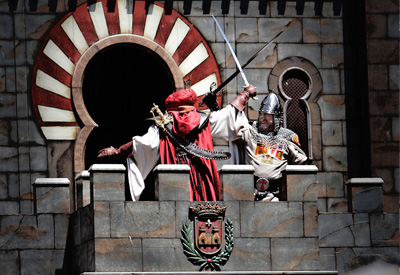
These acts have incorporated other innovations in this last stage of our Festival that have given this act a great deal of emotion. The organization of the firing of the groups in the assault to the castle along Colón Street is remarkable, which has gained in security and aesthetics, and the consequent “encaro” or confrontation of the Captains that ends with the embrace and congratulations of the top officials of the Festival at the gates of the castle.
Since 2009, two great festive people have been in charge of reciting the embassies of our Festival. They are Isidro Juan Gallardo as Christian Ambassador and Damián Varea del Amo as Moorish Ambassador, who have stood out for their good work and their performance of true dramatic vein, as they belong to an amateur theatre group from Elda.
At the moment, both the guerrillas or Alardo and the Embassies constitute one of the most careful and interesting acts of the Elda festivities: every year more and more people participate in them and many more spectators witness them in the framework of the Constitución square, in front of the magnificent wooden castle located in front of the Town Hall, which was inaugurated a few years ago, and which is a symbol of our entire Festival. The courier, the pomp, the entourage of the Ambassador, the Embassy itself, the battle of arquebusiers and the final hand-to-hand fight of the Ambassadors in the assault on the fortress, constitute the structure of an essential act to understand the reality and authenticity of a Moors and Christians Festival like ours.
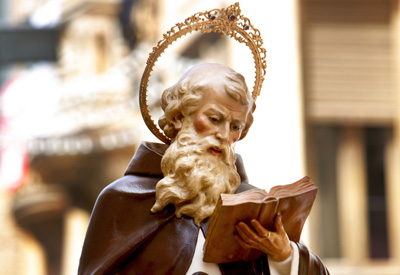
Since 1995 the Procession has won tremendously in organization and protocol. All the groups participate in the streets: San Francisco, Pedrito Rico, Antonino Vera, Pemán, Dahellos, Ortega y Gasset, Nueva, Colón and church. In the last place, the statue of the Saint is carried on the shoulders by partiers belonging every year to the troupe in charge of carrying it by rotating shift. Accompanying the patron saint, the Mayor and Festival Councilor participate as Civil Presidency, and the President of the Central Board and those of the nine groups along with the Stewardship of the Holy Festival, on behalf of the festive people. The ecclesiastical authority is comprised of the priests of the local parishes headed by the parish priest of Santa Ana.
In 2008 there was an innovation in the structure of this act: the procession parade was initiated by a small opening page composed of the guide cross and two candles carried by members of the group in charge of the image of the saint, the banners of the troupes clothing the one of San Antón also supported by festive people of the troupe in charge of the statue and the Moorish and Christian Ambassadors.
Once the image of the Saint reaches the steps of the Parish Church of Santa Ana, the Procession itself ends with the consequent flipping of bells and firing of a large palm tree of fireworks. From there the transfer to the chapel is organized.
